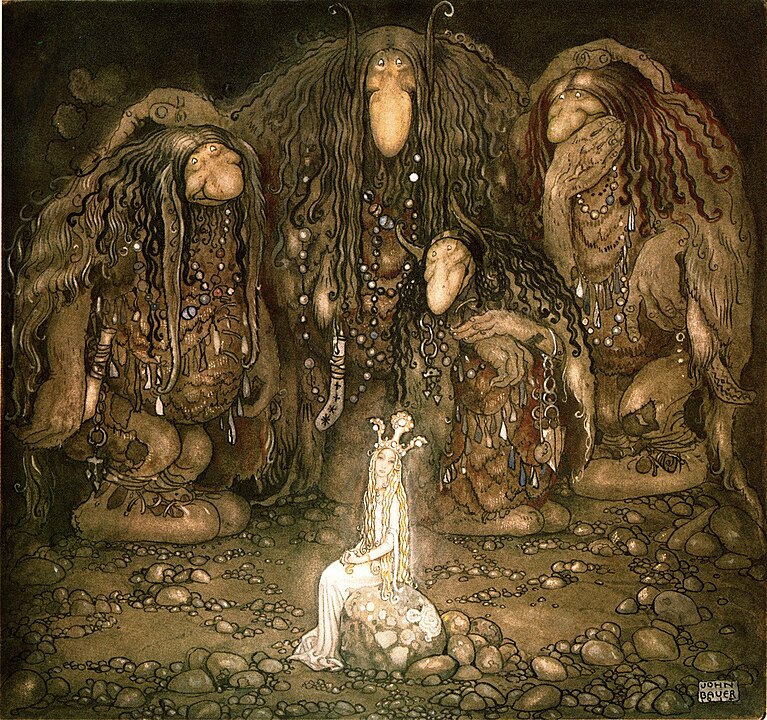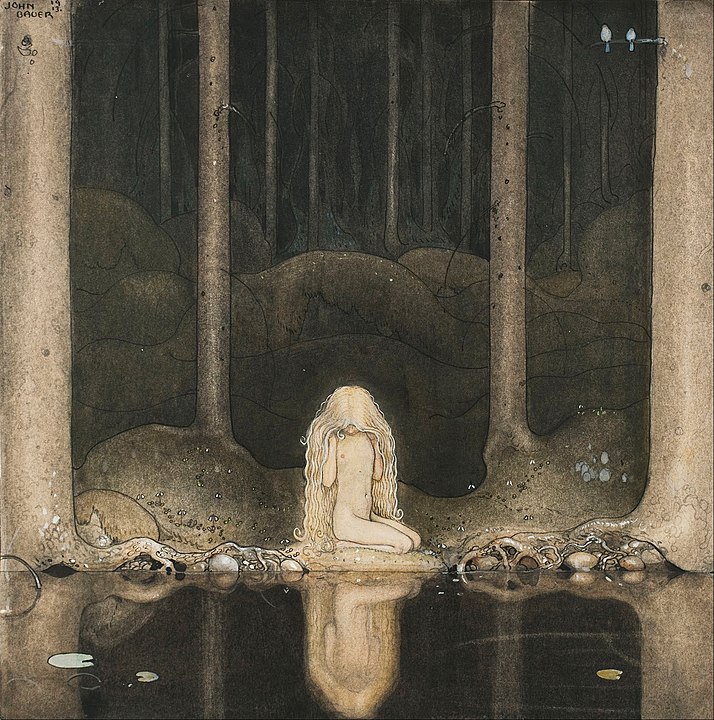
When we think of fairy tales, images of enchanted forests, mythical creatures, and magical realms often dance in our minds. But for many, these visions have a distinct style and charm that can be traced back to one artist: John Bauer. His illustrations have captured the imagination of generations, painting a world where trolls lurk in the shadows and princesses glide through the woods. Yet, behind these timeless images lies the story of a man whose life was as rich and complex as the worlds he created.
Early Life: A Child of Nature
John Albert Bauer was born on June 4, 1882, in the town of Jönköping, Sweden. From the very beginning, nature played a pivotal role in his life. Growing up in a region surrounded by dense forests, shimmering lakes, and the kind of landscape that seems pulled straight from a storybook, young John was immersed in an environment ripe with inspiration. His father, Joseph Bauer, was a German immigrant who worked as a confectioner, and his mother, Emma, was a Swedish native. The family moved to Stockholm when John was just a child, but his heart always belonged to the wilds of Småland, the region where he was born.
As a boy, John was often found wandering through the woods, sketching the flora and fauna that he encountered. These early experiences deeply influenced his artistic vision, embedding within him a love for the natural world that would later become a hallmark of his work. The dense, mysterious forests of Sweden would eventually become the backdrop for many of his most famous illustrations.
A Budding Artist
Recognizing his talent from an early age, Bauer’s parents encouraged his artistic pursuits. At just 16, he enrolled at the Royal Swedish Academy of Fine Arts in Stockholm, where he honed his skills in drawing and painting. The academy provided him with a solid foundation in classical techniques, but it was his exposure to Swedish folklore that truly sparked his imagination.
During his studies, Bauer became deeply interested in the stories and legends that were part of Sweden’s cultural heritage. He was particularly drawn to the works of the Swedish writer and folklorist Helena Nyblom, whose fairy tales were steeped in the mystical traditions of the country. These tales, filled with trolls, fairies, and magical beings, resonated with Bauer and began to influence the direction of his art.
Love and Inspiration: Meeting Ester
In 1903, while still a student at the academy, Bauer met Ester Ellqvist, a fellow art student who would become the love of his life. Ester was a talented artist in her own right, and the two shared a deep connection not only through their love of art but also through their appreciation of nature. Their relationship blossomed, and they were married in 1906. Ester became John’s muse, and her delicate features can be seen in many of the female characters in his illustrations.
The couple spent much of their time traveling through Sweden, exploring the countryside, and finding inspiration in the natural beauty that surrounded them. They often retreated to a small cabin on the shores of Lake Bunn in Småland, where John would spend hours sketching and painting, capturing the essence of the forest and its inhabitants.
The World of Swedish Fairy Tales
Bauer’s big break came in 1907 when he was commissioned to illustrate the annual children’s book series Bland tomtar och troll (Among Gnomes and Trolls). This series, which featured a collection of Swedish fairy tales, would become his most famous work. Over the next decade, Bauer would illustrate numerous volumes of the series, each filled with his distinctive interpretations of the mythical creatures and enchanted landscapes of Swedish folklore.
His illustrations were unlike anything seen before. They were dark and mysterious, yet filled with a sense of wonder and magic. Bauer had a unique ability to capture the essence of a fairy tale, making the fantastical seem real and the real seem fantastical. His trolls, in particular, became iconic—gnarled and grotesque, yet strangely endearing. These creatures were not the fearsome monsters of other European traditions but rather beings that seemed to belong to the earth itself, made of moss and stone, ancient and wise.
Bauer’s use of color and light was also groundbreaking. He often worked in muted tones, using deep greens, browns, and grays to evoke the feeling of a dense, shadowy forest. But he would also introduce splashes of bright color—a princess’s golden hair, a glowing lantern—that brought a sense of life and vibrancy to his compositions.

His work on Bland tomtar och troll made him a household name in Sweden, and his illustrations became synonymous with Swedish fairy tales. But while his art was celebrated, Bauer remained a humble and somewhat introverted figure, more comfortable in the solitude of the forest than in the spotlight of fame.
A Period of Reflection
As his career progressed, Bauer began to struggle with the pressures of his work. The success of Bland tomtar och troll brought with it increasing demands for more illustrations, and the artist found himself torn between the desire to explore new artistic directions and the expectations placed upon him.
In 1914, after years of relentless work, Bauer took a step back from illustrating the series to focus on other projects. He began to experiment with different styles and techniques, exploring more modernist approaches to art. This period of experimentation was both exciting and challenging for Bauer, as he sought to reconcile his love for traditional fairy tale imagery with his desire to evolve as an artist.
However, this period also brought personal challenges. Bauer’s marriage to Ester became strained as the couple grappled with the pressures of their careers and their growing family. The birth of their son, Bengt, in 1915 brought joy but also added to the responsibilities and stresses in Bauer’s life.
A Tragic End
In 1918, Bauer and his family decided to move to a larger home in Stockholm, seeking a fresh start. On November 20th of that year, they boarded the steamboat Per Brahe to transport their belongings across Lake Vättern. The night was stormy, and tragically, the boat capsized in the rough waters. All aboard were lost, including Bauer, Ester, and their young son, Bengt. John Bauer was just 36 years old.
The news of Bauer’s death sent shockwaves through Sweden. The nation mourned the loss of one of its most beloved artists, and his passing marked the end of an era in Swedish illustration. Bauer’s work had come to define the visual representation of Swedish folklore, and his untimely death left a void that would not easily be filled.
Legacy: The Lasting Influence of John Bauer
Despite his short life, John Bauer’s legacy has endured for more than a century. His illustrations continue to captivate audiences, transporting them to a world where the boundaries between reality and fantasy blur. The images he created for Bland tomtar och troll have become iconic, not just in Sweden but around the world, influencing generations of artists, illustrators, and storytellers.
Bauer’s ability to evoke the mystery and magic of the natural world has ensured that his work remains relevant even today. In an age where digital art and animation dominate, Bauer’s hand-drawn illustrations remind us of the power of traditional techniques and the timeless appeal of a well-told story.

In Sweden, Bauer’s influence can be seen in the work of many contemporary artists and illustrators who continue to draw inspiration from his unique style. His work has also found a place in popular culture, with references to his trolls and fairy tale landscapes appearing in everything from children’s books to video games.
Moreover, Bauer’s life and art have been the subject of numerous exhibitions, books, and documentaries, ensuring that new generations continue to discover his work. His home in Småland, with its deep forests and shimmering lakes, has become a place of pilgrimage for fans of his art, offering a glimpse into the landscape that inspired one of Sweden’s greatest artists.
In the end, John Bauer’s story is one of passion, creativity, and an unwavering connection to the natural world. His art invites us to step into the forest, to lose ourselves in the shadows, and to believe, if only for a moment, that magic is real.
Conclusion: A Legacy That Lives On
John Bauer’s life may have been cut tragically short, but his legacy lives on through his art. His illustrations continue to enchant and inspire, offering a window into a world where the impossible seems possible. Whether through the eyes of a child discovering his work for the first time or an artist seeking inspiration in his timeless style, Bauer’s art remains as vital and magical today as it was over a century ago. So, next time you find yourself wandering through a forest, keep an eye out for a flicker of movement in the shadows, a rustling in the leaves. Who knows? You might just stumble upon one of John Bauer’s trolls, patiently waiting for the next page to turn.
Bauer gained prominence as an illustrator during the early 20th century and is closely associated with his contributions to Swedish folklore and fairy tales. His illustrations often accompanied the works of Swedish author Elsa Beskow and others. One of his notable projects was the illustrations for an annual Christmas book published by the Swedish magazine “Bland Tomtar och Troll” (Among Gnomes and Trolls), where he created captivating images that brought Swedish folklore to life.
Tragically, John Bauer’s life was cut short at the age of 36. In 1918, he, along with his wife, and their young son, lost their lives in a shipwreck in Lake Vättern, Sweden. Despite his relatively short career, Bauer’s legacy endures through his influential and iconic illustrations, which continue to captivate audiences and inspire artists to this day. His unique style, characterized by rich colors and a sense of mystery, has left an indelible mark on the world of illustration and fantasy art.




